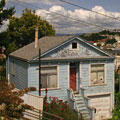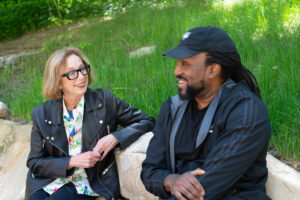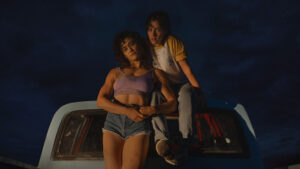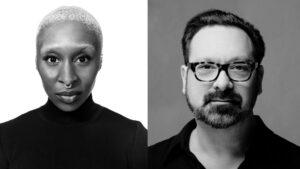Jenni Olson, director, The Royal Road
Writer-director-producer Jenni Olson has been programming, researching, collecting, creating, and writing about lesbian, gay, bi and transgender (LGBT) film since 1986 and is one of the world’s leading experts on LGBT cinema history. Her debut feature film, ‘The Joy of Life,’ premiered at the 2005 Sundance Film Festival and went on to play a pivotal role in renewing debate about the need for a suicide barrier on the Golden Gate Bridge. She is seeking funding through Kickstarter to complete her latest project, ‘The Royal Road.’ Click here to support the film.
As a four-time Sundance Film Festival alum and regular annual attendee, I’ve had so many memorable and life-changing experiences at the Festival over the years that it’s hard to say which is the best. As I’m deep in the midst of a Kickstarter campaign to raise funds for my next film, The Royal Road — with my eye on the prize of submitting to Sundance — I find myself pondering the enormous impact Sundance has had on my career. Specifically, the existence of the New Frontier section has served as a beacon for me and for so many experimental filmmakers — providing a high profile platform at a major U.S. festival and a corresponding validation that genuinely provides hope and encouragement during the creative process.
A little bit of background on the significance of this. When New Frontier founder Shari Frilot was programming for Outfest: The Los Angeles LGBT Film Festival, she created an experimental section (this, in the heart of Hollywood). Rather than relegating this work so often thought of as marginal and arty to some rarefied position where few people would actually go see it, Shari provided a framework showcasing it as the most fabulous thing at the whole Festival. It was dubbed it the Platinum section and made us experimental filmmakers feel like the cool kids. This approach convinced large audiences to experience great films they never would have seen otherwise.
Similarly, the New Frontier section continues to be one of the coolest things at Sundance, especially as it has expanded to include multimedia performances, transmedia, and all manner of cutting edge creative work that goes beyond the traditional cinematic exhibition space. Knowing that I have this venue at which to aspire to showcase my work is an unquestionable motivating force as I plow forward in my ambitious and often hard-to-describe creative work.
I have always found it challenging to adequately characterize in words the complex nature of my filmmaking. I can describe the ostensible topics (in this case an array of historical interests ranging from the Mexican-American War to the life story of Casanova) but of equal, if not greater, importance is the style and cinematic strategy of the storytelling. My simple photographic compositions and the lengthy duration of my shots are crucial components of this creative vision (in my favorite review of my first feature The Joy of Life — which premiered at Sundance in 2005 — The Village Voice called the film “thrillingly minimalist.”)
My dedication to the analog medium of 16mm film is also a significant aspect of my creative aesthetic in achieving the experience I seek to create for my audiences. I have a somewhat elaborate (and perhaps not very scientific) theory about the emotional and psychological impact that 16mm film has on viewers who came of age in the pre-digital world. While I finish and exhibit my work on HD, I am committed to shooting on regular 16mm (and maintaining the 4:3 aspect ratio) as part of this philosophy. This also directly ties into a defense of nostalgia I pursue in The Royal Road in dialogue with a short Tony Kushner lecture on nostalgia and socialism, which serves as the centerpiece of the film.
Through mostly wide and very static long takes, my films preserve a record of California’s rapidly changing urban landscape. I focus my lens primarily on simple scenes of everyday life in the city. With great affection, and an understated sense of civic pride, I aspire to make the mundane heroic and to give viewers a new perspective that they can take out into the world when they leave the theater.
I continue to have enormous faith in the transformative power of art — especially innovative, unconventional forms which cause us to see the world in new ways. I try to achieve this in my own work and continue to be grateful to Sundance for bringing these kinds of films to broader audiences.
As I set my sights on the New Frontier, I invite everyone to join me — even with a mere $10 pledge — in being part of this important new queer experimental feature. Click here to support The Royal Road.
Thank you.




